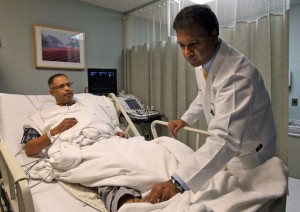
By Laurie Skrivan and Jim Doyle, St. Louis Post-Dispatch –
ST. LOUIS — To improve the quality of health care and cut medical costs, the federal government is focusing increasingly on a simple, though powerful tool: changing hospitals’ financial incentives.
Already, the federal Centers for Medicare and Medicaid Services is penalizing hospitals that provide ineffective medical treatment. Those hospitals with a high percentage of patients who are readmitted for the same condition within 30 days of a hospital stay will receive lower federal reimbursements.
Now, the agency is preparing to test a billing method called “bundled payments” to see if it can spur hospitals to lower treatment costs while delivering high-quality care.
If the pilot program is successful, it could be rolled out nationally to all Medicare patients.
Here’s how the program will work:
—Medicare will reimburse hospitals at a fixed rate for all care related to an individual’s primary diagnosis, such as a patient’s need for knee replacement surgery.
—A hospital that delivers high quality care at a lower cost will make money on a treated patient. But a hospital whose treatment of the patient results in complications, hospital readmission and other problems will bear the cost of that additional care.
This pilot program is a creative way for hospitals and physicians to work together and take better care of patients at lower cost, said Walter Kopp, a hospital consultant based in San Anselmo, Calif.
“The health care industry is entrenched in fee-for-service medicine, and it has to break out,” Kopp said. “This is an attempt to get at that.”
SSM St. Mary’s Health Center in Richmond Heights, Mo., and SSM DePaul Health Center in Bridgeton, Mo., are in the final stage of an application process to join the pilot program sponsored by the CMS Innovation Center, which is responsible for designing and testing models of health care.
CMS soon will select the hospitals for the program, which begins in January.
Emma Sandoe, a CMS spokeswoman, said that bundled payments will “encourage doctors, hospitals and other health care providers to work together to better coordinate care for patients both when they are in the hospital and after they are discharged.”
If selected for the program, St. Mary’s will focus on bundled payments for patients with congestive heart failure, while DePaul will focus on knee replacement surgery.
“Our motivation behind doing this is to provide the best care to the patient that we can — the highest quality of care at the lowest cost possible,” said Dr. Jay Moore, vice president for medical affairs at SSM DePaul. “That’s value. We think that’s the key.”
Missouri Baptist Medical Center in west St. Louis County, which is part of St. Louis-based BJC Healthcare, also is awaiting word of final approval. If given, Missouri Baptist will focus on orthopedics, said Kit Kitson, a BJC spokeswoman.
If successful, the pilot program could be rolled out nationwide, CMS’ Sandoe said.
A bundled payment system is very different from the CMS’ current “encounter-based” system. Under the current system, there are few economic incentives for hospitals to reduce the risks of complications or readmission. Instead, hospitals are rewarded financially when they increase the number of treatments or procedures a patient undergoes.
Typically, a hospital gets reimbursed by Medicare on a preapproved “case rate” for particular transactions, and a separate bill is issued each time a patient deals with a hospital, physician’s office, emergency room, or ambulance. Each visit is treated as a separate billable event.
The current system is ridden with high administrative costs, and gets even more complicated and costly when a patient receives additional care for the original problem at another medical office or hospital.
In a bundled payment system, one payment covers all treatment and procedures related to a patient’s primary diagnosis — regardless of where or when the medical care is given.
Under this new system, the hospital assumes the financial risk for patient care during the entire process: Some patients will be ushered in and out of the system quickly, while others may suffer a complication such as a blood clot that requires additional treatment.
“It puts the accountability for the cost of the care onto the provider (hospital or medical office), rather than the payer (Medicare),” said SSM’s Moore. “That’s better for patients …
“It does not make sense for a patient to have to pay and pay again for the same problem,” he said. “It puts a cap on the total amount that the payer will be responsible for.”
Ultimately, the patient is the payer — either through paying higher taxes or higher insurance premiums. In recent years, the cost of U.S. health care has risen about 8 percent a year.








